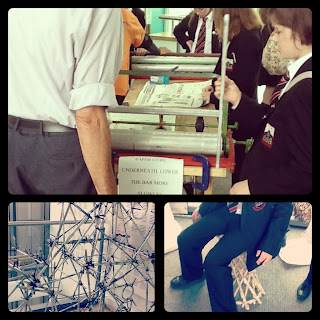Inspired by this tour, I embarked on a slightly altered pathology-in-the-capital expedition.
I started from the Old Operating Theater Museum in London Bridge. The entire museum is at the roof of St Thomas church, built in 1703, which was then part of St Thomas' hospital. At that time, the rich people would get treated at home and only the poor people would seek medical treatment at the hospitals. The surgeons of early 19th century would perform amputations, removal of bladder stones or small operations in the human skulls (tephinations). However, anesthetics and antiseptic conditions were introduced quite later, in 1846 and 1865 respectively, so I can only imagine how a surgery would be before that.
 |
| Picture of how an operation used to be before anesthetics, amputation saws and bandages. |
The operating theater in the museum is the oldest surviving in Europe, built in 1822.
 |
| The operating theater. Picture taken from the museum's website. |
Apart from the theater, you can also see a collection of surgical objects and an apothecary of the medications that were used at that time.
The museum has the coolest entrance (see picture below) and the steepest staircase I've ever seen and it's definitely worth the visit.
 |
| Bed book by Susan Stockwell. A ghostly mattress formed by pages from Nightingale''s own book, notes on nursing, her biographies as well as hospital litterature. |
The museum is a very pleasant space and by involving interactive media is trying to help us understand what the life of this amazing woman involved.
 |
| We peeped through small holes. |
 |
| Tried to imagine what we would do if we were Florence Nightingale (not very successfully..) |
 |
| Heard the story of the Crimean War from its heroes and used very cool audio. |
-Wait...wait...Do you mean this Jon Snow?
-Noo..I mean this John Snow
The famous physician who traced the source of the most intense cholera outbreak in Victorian London and is considered to be one of the fathers of modern epidemiology. He analysed the geography of water supply and mortality patterns in Soho. He noticed that nearly 500 people infected by cholera were living in houses within a few blocks of a single water pump on Broad Street (now Broadwick and Lexington Street). This pump drew water from the heavily contaminated urban stretch of the Thames as well as a nearby well. John Snow associated the pump with the cholera outbreak and the pump handle was removed soon after. The pump used to be at the side entrance of the John Snow pub.
I have to say that his pathology-in-the-town tour was really enjoyable as it introduced me to all these people who helped to change the history of medicine and to a time when receiving medical treatment was a luxury.




.JPG)











.JPG)
.JPG)




.JPG_)
.JPG_)







.JPG_)
.JPG_)
.JPG_)
.JPG)

.JPG_)
.JPG_)

.JPG)
.JPG)

.JPG)

.JPG)
.JPG)
.JPG)